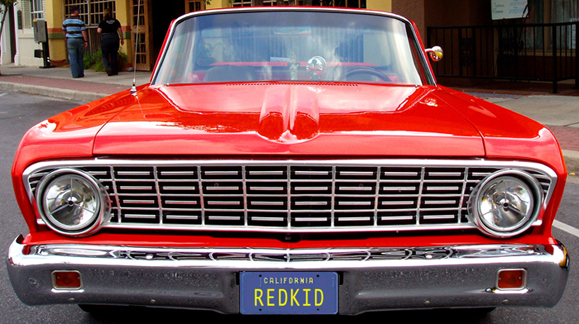MONTVALE, NJ – Mercedes-Benz is unveiling a fourth member of its iconic SL sports car family – the SL63 AMG. Perhaps the sportiest SL roadster ever, the new SL63 AMG is powered by a 6.2-liter, 518-hp, all-AMG V8 engine that’s coupled to a newly developed MCT transmission.
Featuring an innovative start-up clutch that replaces a conventional torque converter, the seven-speed MCT (for multi-clutch technology) transmission combines the direct connection of a manual gearbox with the lightning-quick automatic gear shifts of a Formula 1 race car. Topping off the SL chassis is an even more agile AMG sports suspension based on the Mercedes-Benz ABC active suspension.
MCT Transmission – The Best of Both Worlds
 Providing the direct feedback of a manual transmission with the total convenience of an automatic, the new seven-speed MCT with AMG Speedshift is an all-new design available only in the new SL63 AMG. Featuring seven speeds, four shift modes and a double-clutching function, the MCT transmission offers impressive versatility and even faster shift times.
Providing the direct feedback of a manual transmission with the total convenience of an automatic, the new seven-speed MCT with AMG Speedshift is an all-new design available only in the new SL63 AMG. Featuring seven speeds, four shift modes and a double-clutching function, the MCT transmission offers impressive versatility and even faster shift times.
At the heart of the new AMG Speedshift MCT seven-speed sports transmission is a new start-up clutch, which runs in an oil bath and replaces a conventional torque converter. Thanks to its low rotational mass, the start-up clutch helps the transmission respond instantaneously and dynamically with no slip.
Fitted with four drive modes: “C” (Comfort), “S” (Sport), “S+” (Sport plus) and “M” (Manual), the transmission provides customized shift control for maximum driving pleasure, and does so with no interruption of power. In Comfort mode, smooth shifts coupled with a “soft” accelerator response are set up for silky smooth power transfer. In Sport mode, the engine and transmission interact quicker – upshifts and downshifts take place at higher engine speed. Gearshifts are around 20 percent faster than in Comfort mode. Switching to the Sport Plus mode cuts another 20 percent off shift times, while the sportiest mode, Manual, reduces shifting times by another 10 percent – a total reduction of 50 percent compared with Comfort mode. In Manual mode, the gearshifts take just 100 milliseconds.
Ultra-fast, spontaneous multiple downshifts are another forte of the new MCT sports transmission. For instance, kickdown will shift directly from seventh down to fourth gear or from fifth to second. In the “S” (Sport), “S+” (Sport plus) and “M” (Manual) modes, an automatic double-clutching function is active. Every manual or automatic downshift is accompanied by precisely metered double-clutching – from “S” through “S+” to “M” incrementally. Not only does double-clutching make driving more fun, but virtually load-free downshifting minimizes any jerking, a special benefit when braking into a curve.
The First Engine Developed From the Ground Up by AMG
 The SL63 AMG is powered by an AMG 6.2-liter V8 engine that features four valves per cylinder, variable valve timing, bucket tappets (rather than rocker arms) and a variable intake manifold. Sharing no parts with Mercedes-Benz V8 engines, the 6.3-liter engine was a completely autonomous development at AMG.
The SL63 AMG is powered by an AMG 6.2-liter V8 engine that features four valves per cylinder, variable valve timing, bucket tappets (rather than rocker arms) and a variable intake manifold. Sharing no parts with Mercedes-Benz V8 engines, the 6.3-liter engine was a completely autonomous development at AMG.
Built almost completely from a high-strength silicon-aluminum alloy, the cylinder bores make use of a twin-wire-arc-sprayed (TWAS) coating, a process that results in impressively low friction and running surfaces that are twice as hard as conventional cast-iron cylinders.
The 6.3-liter engine block boasts an especially rigid bedplate acting as the overall support of the main bearings (similar to a one-piece set of main bearing caps), cast-in steel reinforcements and a sturdy closed-deck layout in the cylinder head area. The high-flow intake and exhaust ports form a vertical straight line, helping the 6.3 AMG engine rev freely to more than 7,000 rpm, yet the highly flexible AMG engine still produces nearly 90 percent of its peak torque at only 2,000 rpm.
A finely balanced crankshaft with six counterweights spins in five main crankshaft bearings. The crankshaft counterweights feature heavy metal plugs – a detail usually found only in racing engines – which means they can be significantly smaller, increasing power by reducing rotational inertia and oil drag.
Each forged connecting rod is precisely “cracked” with the help of a laser beam, so the irregular fracture contributes to its strength when the two halves are clamped around the crankshaft. The connecting rods and lightweight pistons are matched for extremely close weight tolerances that contribute to smooth running at high speeds. Small nozzles in the engine block spray cooling oil onto the underside of each piston crown.
“Bucket” Followers Instead of Rocker Arms
 Twin overhead camshafts in each cylinder bank open the 32 valves via bucket-type followers. In other words, instead of rocker arms, the cam lobes sweep across the flat top of the followers, which sit directly on top of the valve stems. This space-saving design provides a very stiff valve train that allows for large valve openings and dependable high-speed operation for maximum horsepower and torque. However, in contrast to racing engines, each bucket incorporates a hydraulic lifter that automatically maintains valve clearance, which allows for long service intervals and low costs.
Twin overhead camshafts in each cylinder bank open the 32 valves via bucket-type followers. In other words, instead of rocker arms, the cam lobes sweep across the flat top of the followers, which sit directly on top of the valve stems. This space-saving design provides a very stiff valve train that allows for large valve openings and dependable high-speed operation for maximum horsepower and torque. However, in contrast to racing engines, each bucket incorporates a hydraulic lifter that automatically maintains valve clearance, which allows for long service intervals and low costs.
The AMG V8 makes use of variable intake and exhaust valve timing to maximize efficiency and torque over a wide RPM range. Valve timing can be automatically adjusted within a range of 40 degrees using electro-hydraulic vane-type adjusters on each camshaft. At part throttle, the valve timing adjuster keeps the exhaust valves open as the intake valves are opening, using this valve overlap for internal exhaust gas recirculation, reducing exhaust emissions and improving fuel economy. However, approaching full throttle, the camshaft adjustment optimizes valve timing for maximum power. The intake cams are driven by a double chain from the crankshaft, and small gears on the intake cams in turn drive the exhaust cams.
The SL63 Gets Unique Styling Touches
 The SL63 comes with a distinctive AMG front hood that’s noticeably different from other SL models, as well as a new front apron with a more pronounced wedge shape, larger cooling air intakes, and a black grille. Bi-xenon headlights with black surrounds and large round fog lights ringed in chrome and set well to the side emphasize the vehicle’s width.
The SL63 comes with a distinctive AMG front hood that’s noticeably different from other SL models, as well as a new front apron with a more pronounced wedge shape, larger cooling air intakes, and a black grille. Bi-xenon headlights with black surrounds and large round fog lights ringed in chrome and set well to the side emphasize the vehicle’s width.
Hot air from the engine exits through side air outlets in the front fenders and from the “gills” behind the front wheels. Trim panels finished in matte silver with “6.3 AMG” lettering catch the eye, as do new outside mirrors with arrow-shaped LED turn indicators.
SL63 AMG body styling also includes deeper AMG side sill panels and a beefy-looking rear apron that incorporates a large black air diffuser and two pairs of chrome tailpipes. An AMG rear lip spoiler on the trunk lid reduces lift, especially at high speeds.
Finished in nappa leather and genuine carbon fiber, the interior features standard AMG sport seats, an AMG three-spoke steering wheel and a sport instrument cluster with red tach and speedometer needles that swing to the max position and back whenever the ignition is turned on.
Optional Performance Package for the SL63 AMG
An optional Performance Package is also available for the SL63 AMG, which includes even higher-performance components that are well suited for sporty-minded drivers:
· Top speed raised to 186 mph · Vented ceramic front brake discs that are 15.3 inches in diameter · Multi-disc limited-slip rear differential with a 40 percent locking factor of for enhanced traction · 19-inch AMG twin-spoke forged light-alloy wheels · Staggered-width tires: 255 / 35 R 19 in front and 285 / 30 R 19 at the rear · AMG high-performance suspension based on ABC active suspension · Smaller AMG sport steering wheel with a flattened underside and silver-aluminum shift paddlesv
AIRSCARF Around the Head and Neck
All 2009 Mercedes-Benz SL roadsters are now available with AIRSCARF, an innovative feature that can extend the open-air driving season into the cooler months. Another technological first from Mercedes, AIRSCARF is an extra heating system built into the driver and passenger seats. At the touch of a button, warm air flows from vents in the head restraints, acting as an invisible scarf around the head and neck.
Testing revealed that warming just a relatively small area around the neck dramatically improves comfort in cooler weather. The AIRSCARF neck-level heating system blows warm air from the head restraints of the driver and passenger seats, allowing occupants to cruise comfortably with the retractable hardtop open in colder weather. AIRSCARF uses a heating element made primarily of barium titanate, which heats up in a matter of seconds when electrical current is applied.
Optional on the V8-powered SL AMG model and standard on the SL65 AMG, the AIRSCARF neck-level heating system even compensates automatically for changes in air temperature and vehicle speed. AIRSCARF comes with a three-speed switch and an electronic control module that monitors data from the speedometer as well as from inside and outside temperature sensors. AIRSCARF automatically adjusts the fan speed based on this information, and at the same time, the switch can override the automatic settings.
New Audio Technology
With its 6.5-inch color display screen, the standard COMAND system with GPS navigation has been refined with a new MMI interface and a four gigabyte hard drive as well as an integrated six-disc CD-DVD player and a Music Register for around 1,000 MP3 tracks. The interface makes it easy to connect an iPod, USB stick, memory card and other devices. Music tracks can be indicated on the COMAND display located on the center console as well as a smaller display in the center of the instrument cluster, and they can be selected easily using the buttons on the multi-function steering wheel.
Any Bluetooth-enabled cell phone will work hands-free – even with the phone in a pocket or purse, the audio is automatically muted when a call is made or received, and callers are heard over the audio system speakers. In addition, phone address book info can be displayed by the COMAND system
From Coupe to Roadster in 16 Seconds
At the push of a button, the SL’s retractable hardtop can be fully opened or closed in just 16 seconds, transforming the car from a quiet, weather-tight coupe to a top-down open-air convertible. A hydraulic pump and 11 computer-controlled hydraulic cylinders power the system, and roof operation is controlled by a switch on the center console. A clever folding design allows for a surprisingly large cargo area of 7.2 cubic feet when the top is down. With the top up, the trunk holds 10.2 cubic feet.
The World’s Safest Convertible
Widely acclaimed as one of the world’s safest convertibles, the SL provides sports car performance with all the built-in safety that’s expected from Mercedes-Benz. Since an open car can leave its occupants vulnerable in a rollover, Mercedes engineers met the challenge in the SL with the world’s first automatic roll bar.
Normally part of the interior’s rear-compartment surround structure, the padded, leather-covered bar pops up, locking in place in a third of a second if sensors detect an impending rollover. The driver can also raise and lower the bar by a switch on the console.
Shoulder belts are integrated directly into the seats for greater occupant protection, especially in rollovers. The Mercedes SL was also the first car with side airbags, which are part of a safety system that includes dual front airbags and emergency tensioning retractors that tighten the seat belts in a collision.
V8 and V12 Power
The two AMG SL roadster models for 2009 feature a choice of V8 and V12 power. The SL63 AMG is powered by a 6.2-liter four-valve-per-cylinder V8 with 518 horsepower and 465 pound-feet of torque, while V12-powered SL65 AMG, makes 604 hp and a monstrous 738 lb.-ft. of torque.
AMG High-Performance Braking
Excellent stopping power for the SL is provided by large, four-wheel disc brakes enhanced with four-channel ABS anti-lock control. Matched to its power and speed capability, the SL63 AMG comes with large 14.2-inch vented rotors up front and 13.0-inch vented rotors at the rear, while the SL65 AMG boasts vented discs that are another 1.2 inches in diameter.
Also new are 19-inch AMG staggered-width alloy wheels – 8.5 and 9.5 inches wide – fitted with 255 / 35 R 19 (front) and 285 / 30 R 19 (rear) tires. With triple-spoke styling and a titanium grey finish, the AMG alloy wheels complement the new AMG body styling.
ABC Active Suspension Gives Cat-Like Agility
The SL chassis uses a fully independent, double-control-arm front suspension and the patented Mercedes-Benz five-link rear suspension. All SL models come with second-generation Active Body Control (ABC), the Mercedes-Benz active-suspension technology that virtually eliminates body roll in cornering, squat under acceleration and dive during braking.
Each SL uses software programming specific to the model, akin to tuning the spring rates, shock damping and roll stiffness of a conventional suspension. Special AMG struts with firmer damping and fully reworked systems such as ABS anti-lock brakes, Brake Assist, ASR traction control and ESP stability control complement the enhanced AMG chassis.
Mercedes-Benz engineers use ABC’s interplay of hydraulic, electronic and mechanical parts to reduce body roll by 68 percent (compared to the same vehicle with a conventional suspension), providing the driver with needed feedback through the vehicle chassis. A ‘Sport’ switch on the center console can make it 95 percent reduced roll, along with tighter shock damping. Active suspension solves the usual tradeoff between ride comfort and handling precision, so SL roadsters offer excellent comfort and league-leading handling.
 Developed as a technological showcase for Mitsubishi Motors, the Concept-RA displays athletic sport coupe proportions wrapped in dynamic flowing lines that provide a powerful and compelling showpiece for the car's advanced, high technology features. Broad, muscular wheel arches house 21-inch wheels and lend graphic expression to the high degree of road control and tenacious grip afforded by the next generation S-AWC system. Meanwhile, an exposed engine cover highlights the presence of the car's high output, efficient, clean diesel engine design. The Concept-RA's inverted-slant nose and trapezoidal grille fascia reinforce Mitsubishi Motors' new design identity, albeit suitably revised to reflect the concept's sporty coupe attributes.
Developed as a technological showcase for Mitsubishi Motors, the Concept-RA displays athletic sport coupe proportions wrapped in dynamic flowing lines that provide a powerful and compelling showpiece for the car's advanced, high technology features. Broad, muscular wheel arches house 21-inch wheels and lend graphic expression to the high degree of road control and tenacious grip afforded by the next generation S-AWC system. Meanwhile, an exposed engine cover highlights the presence of the car's high output, efficient, clean diesel engine design. The Concept-RA's inverted-slant nose and trapezoidal grille fascia reinforce Mitsubishi Motors' new design identity, albeit suitably revised to reflect the concept's sporty coupe attributes. The Mitsubishi Concept-RA's Super-All Wheel Control driveline is a next generation all-wheel-drive system that adds Active Steering and Active Suspension control to the ACD1, AYC2, ASC3, and Sport ABS components that comprise the highly capable system used on the 2008 Lancer Evolution. Concept RA's S-AWC system integrally manages these components to realize advanced levels of control over drive torque, steering input, vehicle roll, and braking at each wheel, thereby raising traction, cornering and vehicle stability levels. Such capability affords Concept-RA intuitive, on-demand vehicle behavior that faithfully reflects driver intent by reacting instantly, under a variety of driving conditions, from everyday use to emergency avoidance situations.
The Mitsubishi Concept-RA's Super-All Wheel Control driveline is a next generation all-wheel-drive system that adds Active Steering and Active Suspension control to the ACD1, AYC2, ASC3, and Sport ABS components that comprise the highly capable system used on the 2008 Lancer Evolution. Concept RA's S-AWC system integrally manages these components to realize advanced levels of control over drive torque, steering input, vehicle roll, and braking at each wheel, thereby raising traction, cornering and vehicle stability levels. Such capability affords Concept-RA intuitive, on-demand vehicle behavior that faithfully reflects driver intent by reacting instantly, under a variety of driving conditions, from everyday use to emergency avoidance situations.
























































